Self-Awareness in Healthcare: Enhancing Communication & Care
VerifiedAdded on 2023/06/11
|13
|3156
|223
Essay
AI Summary
This essay delves into the concept of self-awareness and its significant role in healthcare, particularly in enhancing communication between healthcare providers and patients. It defines self-awareness, explores its application in therapy, and highlights the benefits it offers to both medical professionals and patients. The essay emphasizes how self-awareness enables healthcare providers to better understand and manage their emotions, improve diagnostic accuracy, and foster stronger patient-provider relationships. For patients, self-awareness facilitates the ability to articulate their feelings and sensations, leading to more effective treatment and improved overall care quality. The discussion also touches on the importance of reflective practice and emotional intelligence as key components of self-awareness in the healthcare context, ultimately advocating for the integration of self-awareness practices to promote professionalism and holistic patient care. Desklib provides a platform to access this document and many similar solved assignments.

SELF-AWARENESS
1
1
Paraphrase This Document
Need a fresh take? Get an instant paraphrase of this document with our AI Paraphraser
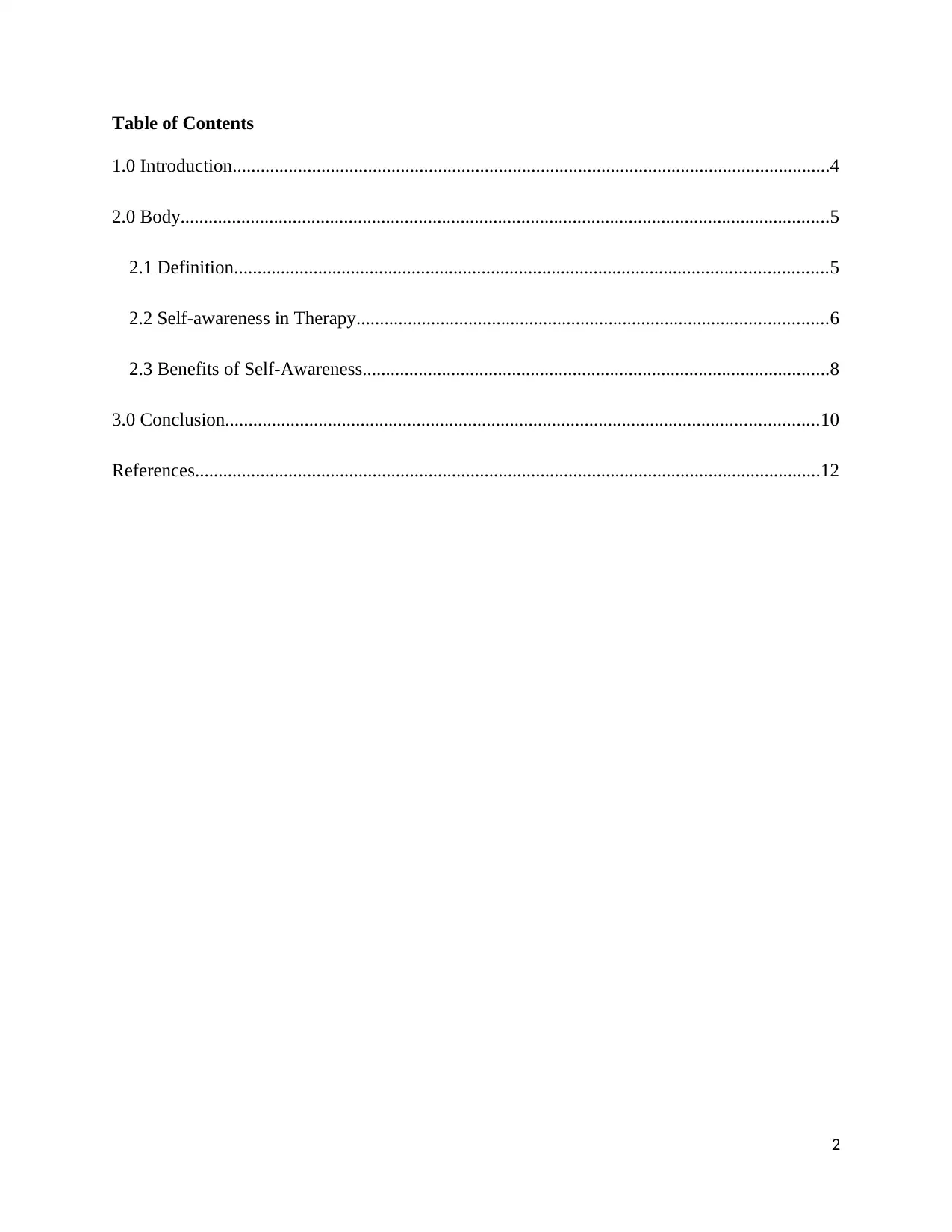
Table of Contents
1.0 Introduction................................................................................................................................4
2.0 Body...........................................................................................................................................5
2.1 Definition...............................................................................................................................5
2.2 Self-awareness in Therapy.....................................................................................................6
2.3 Benefits of Self-Awareness....................................................................................................8
3.0 Conclusion...............................................................................................................................10
References......................................................................................................................................12
2
1.0 Introduction................................................................................................................................4
2.0 Body...........................................................................................................................................5
2.1 Definition...............................................................................................................................5
2.2 Self-awareness in Therapy.....................................................................................................6
2.3 Benefits of Self-Awareness....................................................................................................8
3.0 Conclusion...............................................................................................................................10
References......................................................................................................................................12
2
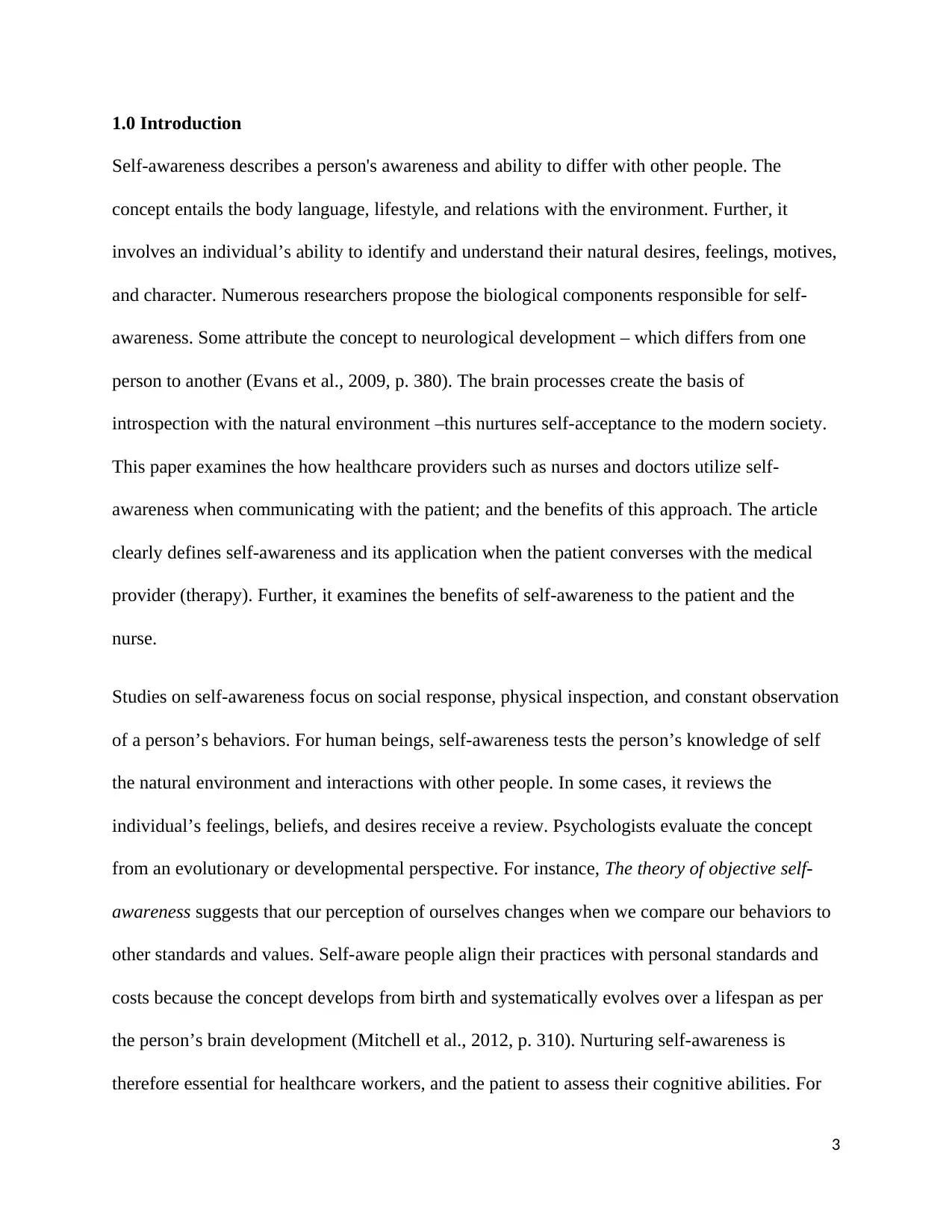
1.0 Introduction
Self-awareness describes a person's awareness and ability to differ with other people. The
concept entails the body language, lifestyle, and relations with the environment. Further, it
involves an individual’s ability to identify and understand their natural desires, feelings, motives,
and character. Numerous researchers propose the biological components responsible for self-
awareness. Some attribute the concept to neurological development – which differs from one
person to another (Evans et al., 2009, p. 380). The brain processes create the basis of
introspection with the natural environment –this nurtures self-acceptance to the modern society.
This paper examines the how healthcare providers such as nurses and doctors utilize self-
awareness when communicating with the patient; and the benefits of this approach. The article
clearly defines self-awareness and its application when the patient converses with the medical
provider (therapy). Further, it examines the benefits of self-awareness to the patient and the
nurse.
Studies on self-awareness focus on social response, physical inspection, and constant observation
of a person’s behaviors. For human beings, self-awareness tests the person’s knowledge of self
the natural environment and interactions with other people. In some cases, it reviews the
individual’s feelings, beliefs, and desires receive a review. Psychologists evaluate the concept
from an evolutionary or developmental perspective. For instance, The theory of objective self-
awareness suggests that our perception of ourselves changes when we compare our behaviors to
other standards and values. Self-aware people align their practices with personal standards and
costs because the concept develops from birth and systematically evolves over a lifespan as per
the person’s brain development (Mitchell et al., 2012, p. 310). Nurturing self-awareness is
therefore essential for healthcare workers, and the patient to assess their cognitive abilities. For
3
Self-awareness describes a person's awareness and ability to differ with other people. The
concept entails the body language, lifestyle, and relations with the environment. Further, it
involves an individual’s ability to identify and understand their natural desires, feelings, motives,
and character. Numerous researchers propose the biological components responsible for self-
awareness. Some attribute the concept to neurological development – which differs from one
person to another (Evans et al., 2009, p. 380). The brain processes create the basis of
introspection with the natural environment –this nurtures self-acceptance to the modern society.
This paper examines the how healthcare providers such as nurses and doctors utilize self-
awareness when communicating with the patient; and the benefits of this approach. The article
clearly defines self-awareness and its application when the patient converses with the medical
provider (therapy). Further, it examines the benefits of self-awareness to the patient and the
nurse.
Studies on self-awareness focus on social response, physical inspection, and constant observation
of a person’s behaviors. For human beings, self-awareness tests the person’s knowledge of self
the natural environment and interactions with other people. In some cases, it reviews the
individual’s feelings, beliefs, and desires receive a review. Psychologists evaluate the concept
from an evolutionary or developmental perspective. For instance, The theory of objective self-
awareness suggests that our perception of ourselves changes when we compare our behaviors to
other standards and values. Self-aware people align their practices with personal standards and
costs because the concept develops from birth and systematically evolves over a lifespan as per
the person’s brain development (Mitchell et al., 2012, p. 310). Nurturing self-awareness is
therefore essential for healthcare workers, and the patient to assess their cognitive abilities. For
3
⊘ This is a preview!⊘
Do you want full access?
Subscribe today to unlock all pages.

Trusted by 1+ million students worldwide
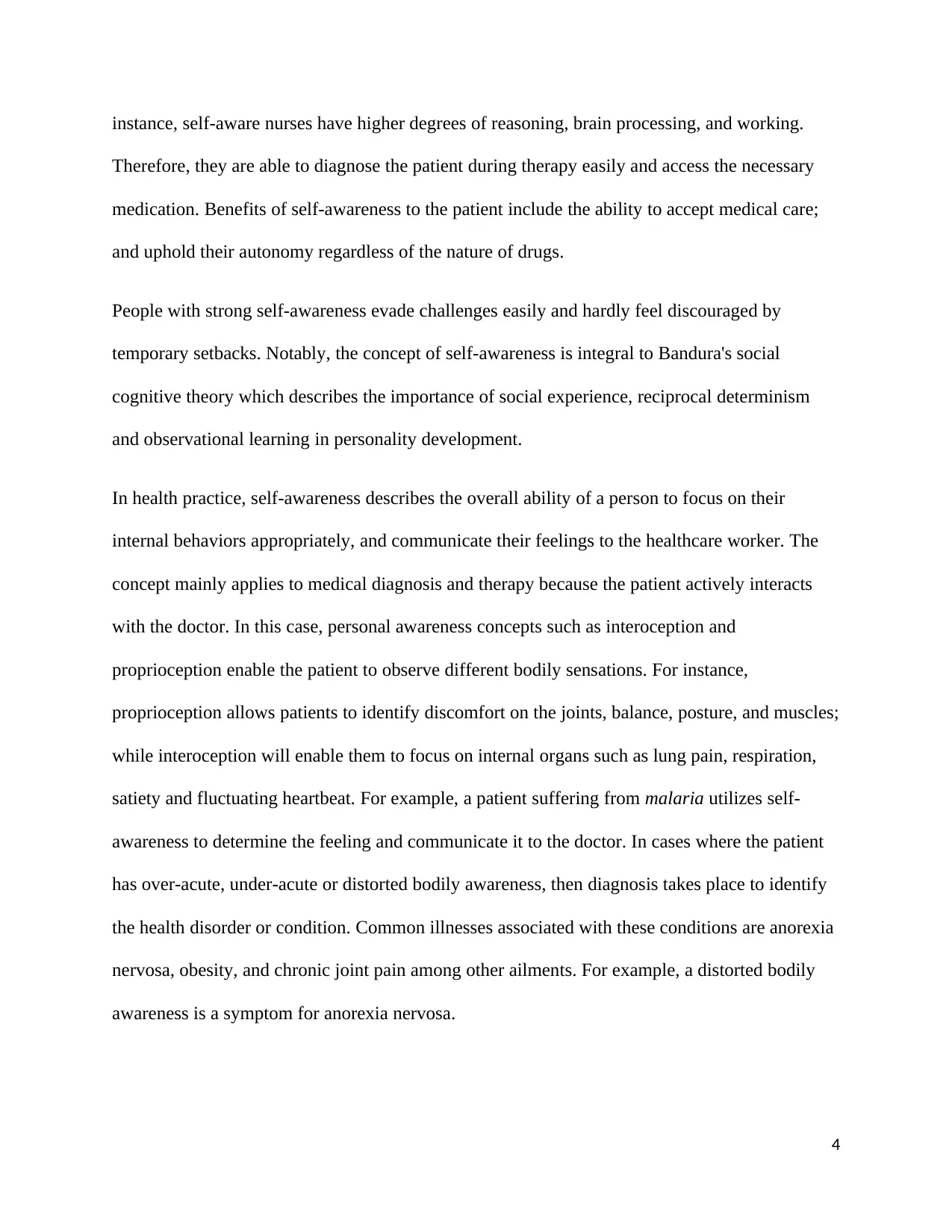
instance, self-aware nurses have higher degrees of reasoning, brain processing, and working.
Therefore, they are able to diagnose the patient during therapy easily and access the necessary
medication. Benefits of self-awareness to the patient include the ability to accept medical care;
and uphold their autonomy regardless of the nature of drugs.
People with strong self-awareness evade challenges easily and hardly feel discouraged by
temporary setbacks. Notably, the concept of self-awareness is integral to Bandura's social
cognitive theory which describes the importance of social experience, reciprocal determinism
and observational learning in personality development.
In health practice, self-awareness describes the overall ability of a person to focus on their
internal behaviors appropriately, and communicate their feelings to the healthcare worker. The
concept mainly applies to medical diagnosis and therapy because the patient actively interacts
with the doctor. In this case, personal awareness concepts such as interoception and
proprioception enable the patient to observe different bodily sensations. For instance,
proprioception allows patients to identify discomfort on the joints, balance, posture, and muscles;
while interoception will enable them to focus on internal organs such as lung pain, respiration,
satiety and fluctuating heartbeat. For example, a patient suffering from malaria utilizes self-
awareness to determine the feeling and communicate it to the doctor. In cases where the patient
has over-acute, under-acute or distorted bodily awareness, then diagnosis takes place to identify
the health disorder or condition. Common illnesses associated with these conditions are anorexia
nervosa, obesity, and chronic joint pain among other ailments. For example, a distorted bodily
awareness is a symptom for anorexia nervosa.
4
Therefore, they are able to diagnose the patient during therapy easily and access the necessary
medication. Benefits of self-awareness to the patient include the ability to accept medical care;
and uphold their autonomy regardless of the nature of drugs.
People with strong self-awareness evade challenges easily and hardly feel discouraged by
temporary setbacks. Notably, the concept of self-awareness is integral to Bandura's social
cognitive theory which describes the importance of social experience, reciprocal determinism
and observational learning in personality development.
In health practice, self-awareness describes the overall ability of a person to focus on their
internal behaviors appropriately, and communicate their feelings to the healthcare worker. The
concept mainly applies to medical diagnosis and therapy because the patient actively interacts
with the doctor. In this case, personal awareness concepts such as interoception and
proprioception enable the patient to observe different bodily sensations. For instance,
proprioception allows patients to identify discomfort on the joints, balance, posture, and muscles;
while interoception will enable them to focus on internal organs such as lung pain, respiration,
satiety and fluctuating heartbeat. For example, a patient suffering from malaria utilizes self-
awareness to determine the feeling and communicate it to the doctor. In cases where the patient
has over-acute, under-acute or distorted bodily awareness, then diagnosis takes place to identify
the health disorder or condition. Common illnesses associated with these conditions are anorexia
nervosa, obesity, and chronic joint pain among other ailments. For example, a distorted bodily
awareness is a symptom for anorexia nervosa.
4
Paraphrase This Document
Need a fresh take? Get an instant paraphrase of this document with our AI Paraphraser
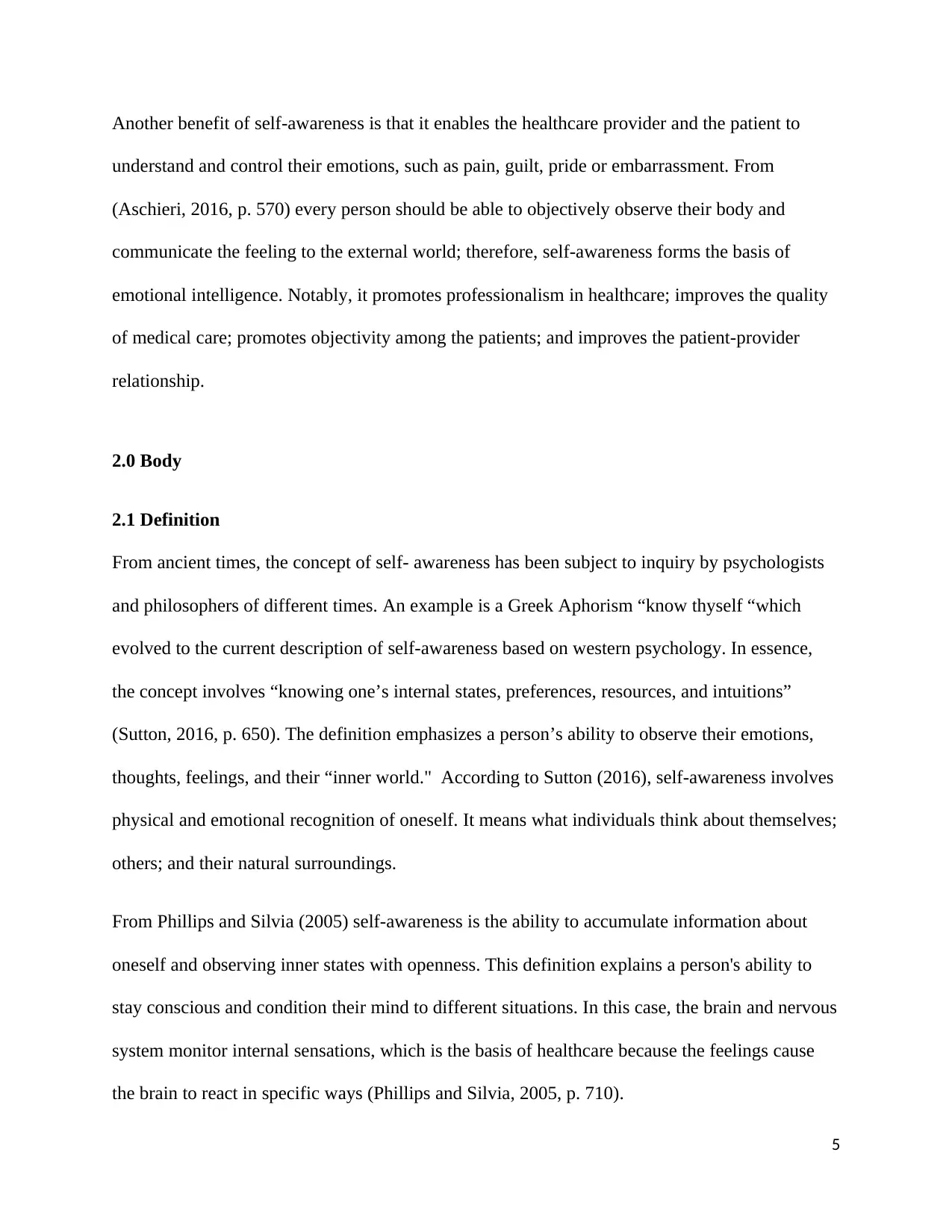
Another benefit of self-awareness is that it enables the healthcare provider and the patient to
understand and control their emotions, such as pain, guilt, pride or embarrassment. From
(Aschieri, 2016, p. 570) every person should be able to objectively observe their body and
communicate the feeling to the external world; therefore, self-awareness forms the basis of
emotional intelligence. Notably, it promotes professionalism in healthcare; improves the quality
of medical care; promotes objectivity among the patients; and improves the patient-provider
relationship.
2.0 Body
2.1 Definition
From ancient times, the concept of self- awareness has been subject to inquiry by psychologists
and philosophers of different times. An example is a Greek Aphorism “know thyself “which
evolved to the current description of self-awareness based on western psychology. In essence,
the concept involves “knowing one’s internal states, preferences, resources, and intuitions”
(Sutton, 2016, p. 650). The definition emphasizes a person’s ability to observe their emotions,
thoughts, feelings, and their “inner world." According to Sutton (2016), self-awareness involves
physical and emotional recognition of oneself. It means what individuals think about themselves;
others; and their natural surroundings.
From Phillips and Silvia (2005) self-awareness is the ability to accumulate information about
oneself and observing inner states with openness. This definition explains a person's ability to
stay conscious and condition their mind to different situations. In this case, the brain and nervous
system monitor internal sensations, which is the basis of healthcare because the feelings cause
the brain to react in specific ways (Phillips and Silvia, 2005, p. 710).
5
understand and control their emotions, such as pain, guilt, pride or embarrassment. From
(Aschieri, 2016, p. 570) every person should be able to objectively observe their body and
communicate the feeling to the external world; therefore, self-awareness forms the basis of
emotional intelligence. Notably, it promotes professionalism in healthcare; improves the quality
of medical care; promotes objectivity among the patients; and improves the patient-provider
relationship.
2.0 Body
2.1 Definition
From ancient times, the concept of self- awareness has been subject to inquiry by psychologists
and philosophers of different times. An example is a Greek Aphorism “know thyself “which
evolved to the current description of self-awareness based on western psychology. In essence,
the concept involves “knowing one’s internal states, preferences, resources, and intuitions”
(Sutton, 2016, p. 650). The definition emphasizes a person’s ability to observe their emotions,
thoughts, feelings, and their “inner world." According to Sutton (2016), self-awareness involves
physical and emotional recognition of oneself. It means what individuals think about themselves;
others; and their natural surroundings.
From Phillips and Silvia (2005) self-awareness is the ability to accumulate information about
oneself and observing inner states with openness. This definition explains a person's ability to
stay conscious and condition their mind to different situations. In this case, the brain and nervous
system monitor internal sensations, which is the basis of healthcare because the feelings cause
the brain to react in specific ways (Phillips and Silvia, 2005, p. 710).
5
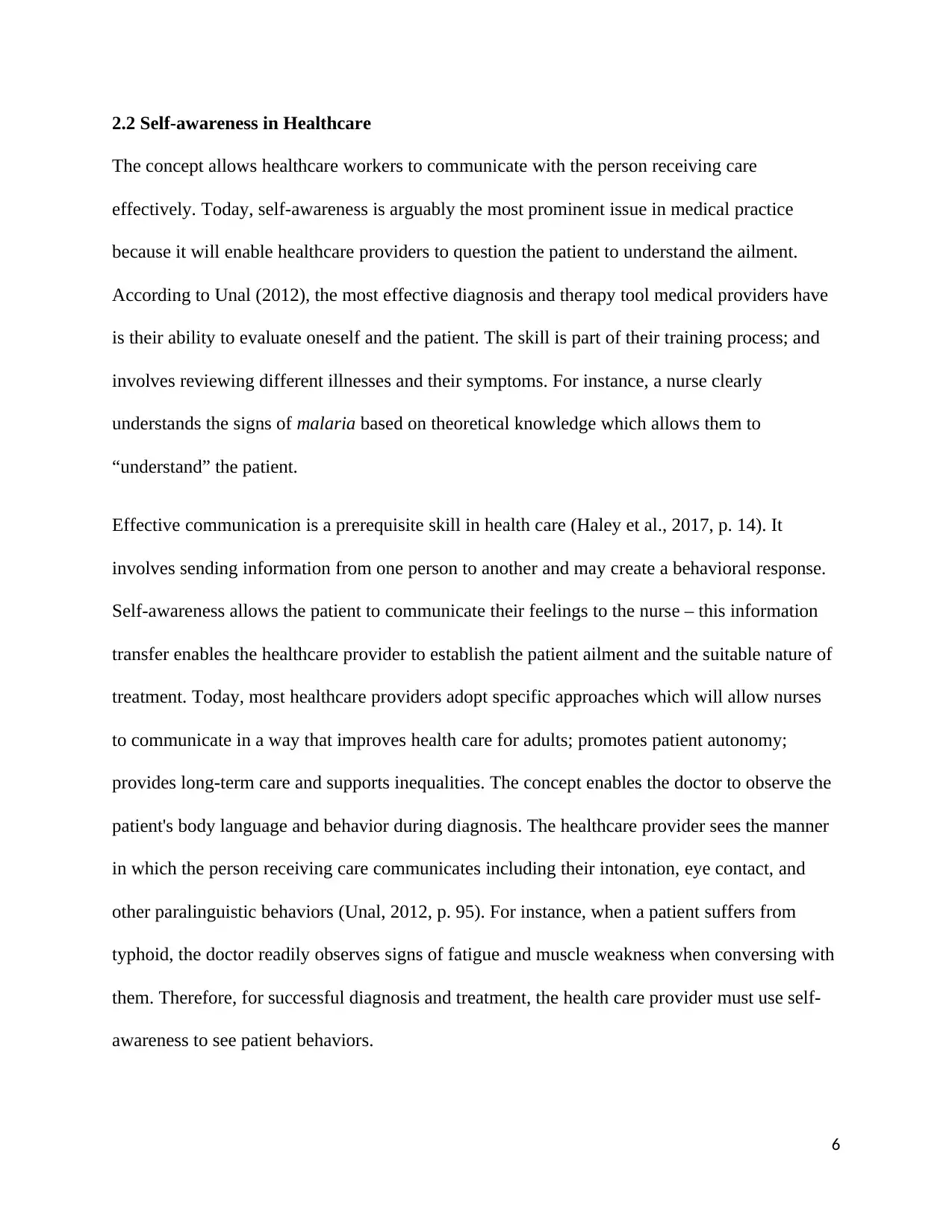
2.2 Self-awareness in Healthcare
The concept allows healthcare workers to communicate with the person receiving care
effectively. Today, self-awareness is arguably the most prominent issue in medical practice
because it will enable healthcare providers to question the patient to understand the ailment.
According to Unal (2012), the most effective diagnosis and therapy tool medical providers have
is their ability to evaluate oneself and the patient. The skill is part of their training process; and
involves reviewing different illnesses and their symptoms. For instance, a nurse clearly
understands the signs of malaria based on theoretical knowledge which allows them to
“understand” the patient.
Effective communication is a prerequisite skill in health care (Haley et al., 2017, p. 14). It
involves sending information from one person to another and may create a behavioral response.
Self-awareness allows the patient to communicate their feelings to the nurse – this information
transfer enables the healthcare provider to establish the patient ailment and the suitable nature of
treatment. Today, most healthcare providers adopt specific approaches which will allow nurses
to communicate in a way that improves health care for adults; promotes patient autonomy;
provides long-term care and supports inequalities. The concept enables the doctor to observe the
patient's body language and behavior during diagnosis. The healthcare provider sees the manner
in which the person receiving care communicates including their intonation, eye contact, and
other paralinguistic behaviors (Unal, 2012, p. 95). For instance, when a patient suffers from
typhoid, the doctor readily observes signs of fatigue and muscle weakness when conversing with
them. Therefore, for successful diagnosis and treatment, the health care provider must use self-
awareness to see patient behaviors.
6
The concept allows healthcare workers to communicate with the person receiving care
effectively. Today, self-awareness is arguably the most prominent issue in medical practice
because it will enable healthcare providers to question the patient to understand the ailment.
According to Unal (2012), the most effective diagnosis and therapy tool medical providers have
is their ability to evaluate oneself and the patient. The skill is part of their training process; and
involves reviewing different illnesses and their symptoms. For instance, a nurse clearly
understands the signs of malaria based on theoretical knowledge which allows them to
“understand” the patient.
Effective communication is a prerequisite skill in health care (Haley et al., 2017, p. 14). It
involves sending information from one person to another and may create a behavioral response.
Self-awareness allows the patient to communicate their feelings to the nurse – this information
transfer enables the healthcare provider to establish the patient ailment and the suitable nature of
treatment. Today, most healthcare providers adopt specific approaches which will allow nurses
to communicate in a way that improves health care for adults; promotes patient autonomy;
provides long-term care and supports inequalities. The concept enables the doctor to observe the
patient's body language and behavior during diagnosis. The healthcare provider sees the manner
in which the person receiving care communicates including their intonation, eye contact, and
other paralinguistic behaviors (Unal, 2012, p. 95). For instance, when a patient suffers from
typhoid, the doctor readily observes signs of fatigue and muscle weakness when conversing with
them. Therefore, for successful diagnosis and treatment, the health care provider must use self-
awareness to see patient behaviors.
6
⊘ This is a preview!⊘
Do you want full access?
Subscribe today to unlock all pages.

Trusted by 1+ million students worldwide
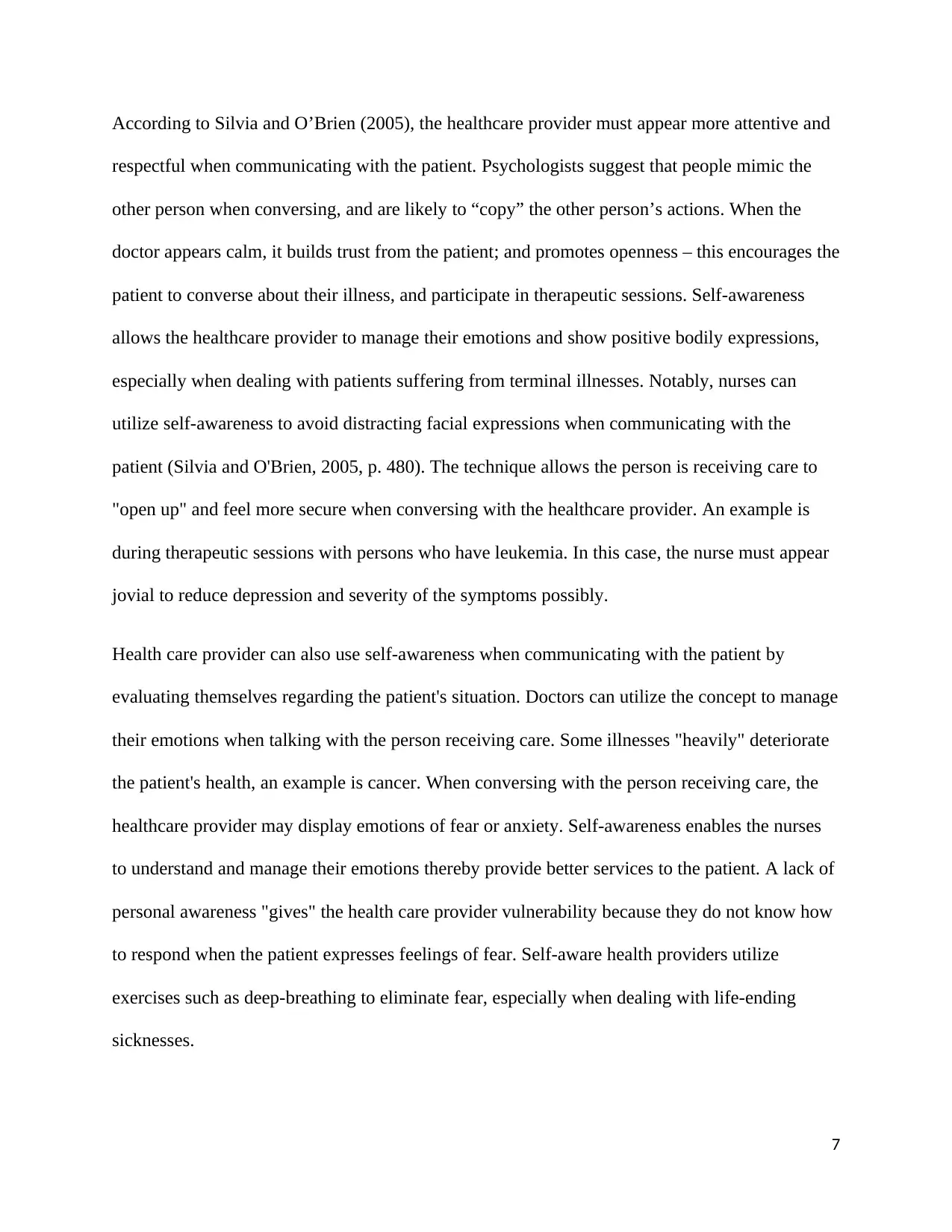
According to Silvia and O’Brien (2005), the healthcare provider must appear more attentive and
respectful when communicating with the patient. Psychologists suggest that people mimic the
other person when conversing, and are likely to “copy” the other person’s actions. When the
doctor appears calm, it builds trust from the patient; and promotes openness – this encourages the
patient to converse about their illness, and participate in therapeutic sessions. Self-awareness
allows the healthcare provider to manage their emotions and show positive bodily expressions,
especially when dealing with patients suffering from terminal illnesses. Notably, nurses can
utilize self-awareness to avoid distracting facial expressions when communicating with the
patient (Silvia and O'Brien, 2005, p. 480). The technique allows the person is receiving care to
"open up" and feel more secure when conversing with the healthcare provider. An example is
during therapeutic sessions with persons who have leukemia. In this case, the nurse must appear
jovial to reduce depression and severity of the symptoms possibly.
Health care provider can also use self-awareness when communicating with the patient by
evaluating themselves regarding the patient's situation. Doctors can utilize the concept to manage
their emotions when talking with the person receiving care. Some illnesses "heavily" deteriorate
the patient's health, an example is cancer. When conversing with the person receiving care, the
healthcare provider may display emotions of fear or anxiety. Self-awareness enables the nurses
to understand and manage their emotions thereby provide better services to the patient. A lack of
personal awareness "gives" the health care provider vulnerability because they do not know how
to respond when the patient expresses feelings of fear. Self-aware health providers utilize
exercises such as deep-breathing to eliminate fear, especially when dealing with life-ending
sicknesses.
7
respectful when communicating with the patient. Psychologists suggest that people mimic the
other person when conversing, and are likely to “copy” the other person’s actions. When the
doctor appears calm, it builds trust from the patient; and promotes openness – this encourages the
patient to converse about their illness, and participate in therapeutic sessions. Self-awareness
allows the healthcare provider to manage their emotions and show positive bodily expressions,
especially when dealing with patients suffering from terminal illnesses. Notably, nurses can
utilize self-awareness to avoid distracting facial expressions when communicating with the
patient (Silvia and O'Brien, 2005, p. 480). The technique allows the person is receiving care to
"open up" and feel more secure when conversing with the healthcare provider. An example is
during therapeutic sessions with persons who have leukemia. In this case, the nurse must appear
jovial to reduce depression and severity of the symptoms possibly.
Health care provider can also use self-awareness when communicating with the patient by
evaluating themselves regarding the patient's situation. Doctors can utilize the concept to manage
their emotions when talking with the person receiving care. Some illnesses "heavily" deteriorate
the patient's health, an example is cancer. When conversing with the person receiving care, the
healthcare provider may display emotions of fear or anxiety. Self-awareness enables the nurses
to understand and manage their emotions thereby provide better services to the patient. A lack of
personal awareness "gives" the health care provider vulnerability because they do not know how
to respond when the patient expresses feelings of fear. Self-aware health providers utilize
exercises such as deep-breathing to eliminate fear, especially when dealing with life-ending
sicknesses.
7
Paraphrase This Document
Need a fresh take? Get an instant paraphrase of this document with our AI Paraphraser
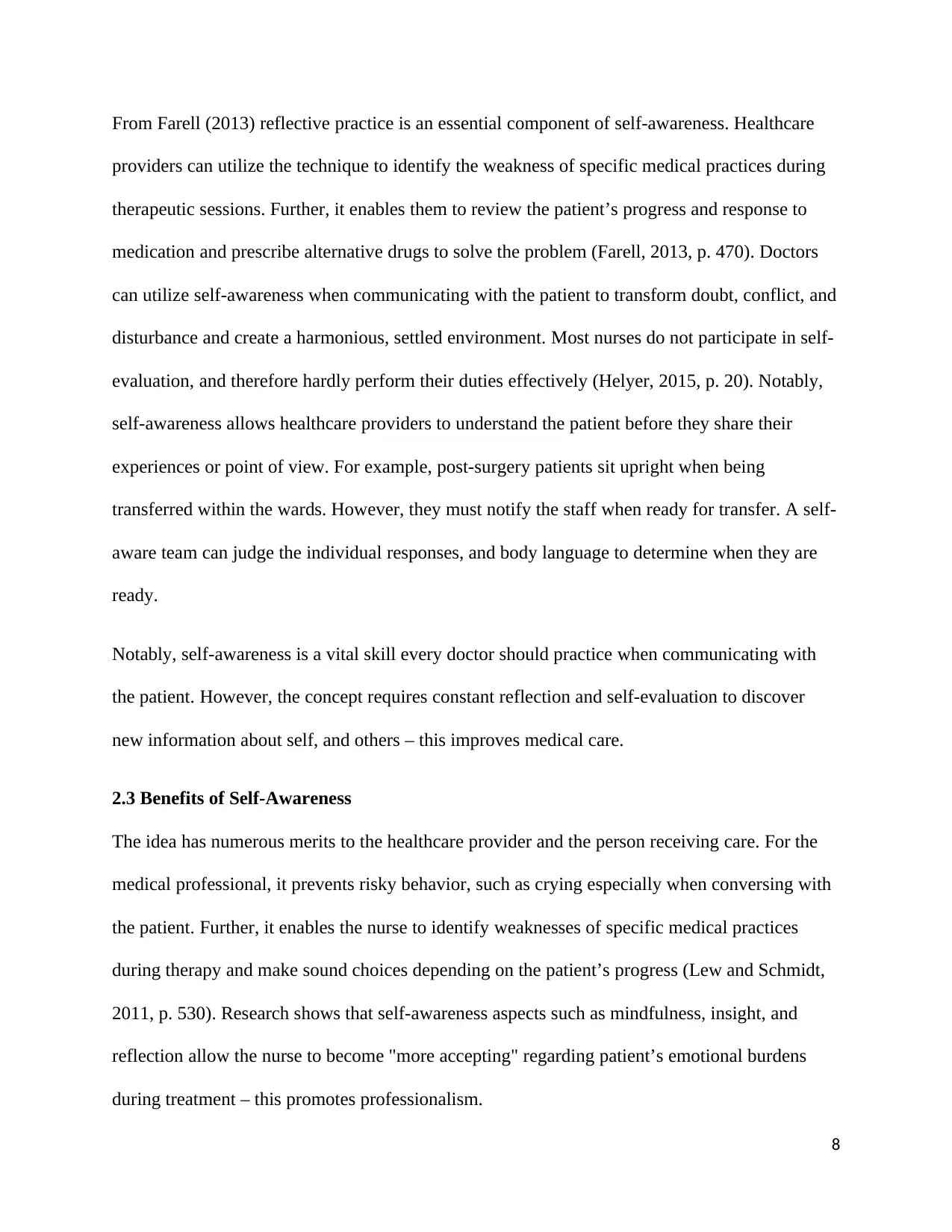
From Farell (2013) reflective practice is an essential component of self-awareness. Healthcare
providers can utilize the technique to identify the weakness of specific medical practices during
therapeutic sessions. Further, it enables them to review the patient’s progress and response to
medication and prescribe alternative drugs to solve the problem (Farell, 2013, p. 470). Doctors
can utilize self-awareness when communicating with the patient to transform doubt, conflict, and
disturbance and create a harmonious, settled environment. Most nurses do not participate in self-
evaluation, and therefore hardly perform their duties effectively (Helyer, 2015, p. 20). Notably,
self-awareness allows healthcare providers to understand the patient before they share their
experiences or point of view. For example, post-surgery patients sit upright when being
transferred within the wards. However, they must notify the staff when ready for transfer. A self-
aware team can judge the individual responses, and body language to determine when they are
ready.
Notably, self-awareness is a vital skill every doctor should practice when communicating with
the patient. However, the concept requires constant reflection and self-evaluation to discover
new information about self, and others – this improves medical care.
2.3 Benefits of Self-Awareness
The idea has numerous merits to the healthcare provider and the person receiving care. For the
medical professional, it prevents risky behavior, such as crying especially when conversing with
the patient. Further, it enables the nurse to identify weaknesses of specific medical practices
during therapy and make sound choices depending on the patient’s progress (Lew and Schmidt,
2011, p. 530). Research shows that self-awareness aspects such as mindfulness, insight, and
reflection allow the nurse to become "more accepting" regarding patient’s emotional burdens
during treatment – this promotes professionalism.
8
providers can utilize the technique to identify the weakness of specific medical practices during
therapeutic sessions. Further, it enables them to review the patient’s progress and response to
medication and prescribe alternative drugs to solve the problem (Farell, 2013, p. 470). Doctors
can utilize self-awareness when communicating with the patient to transform doubt, conflict, and
disturbance and create a harmonious, settled environment. Most nurses do not participate in self-
evaluation, and therefore hardly perform their duties effectively (Helyer, 2015, p. 20). Notably,
self-awareness allows healthcare providers to understand the patient before they share their
experiences or point of view. For example, post-surgery patients sit upright when being
transferred within the wards. However, they must notify the staff when ready for transfer. A self-
aware team can judge the individual responses, and body language to determine when they are
ready.
Notably, self-awareness is a vital skill every doctor should practice when communicating with
the patient. However, the concept requires constant reflection and self-evaluation to discover
new information about self, and others – this improves medical care.
2.3 Benefits of Self-Awareness
The idea has numerous merits to the healthcare provider and the person receiving care. For the
medical professional, it prevents risky behavior, such as crying especially when conversing with
the patient. Further, it enables the nurse to identify weaknesses of specific medical practices
during therapy and make sound choices depending on the patient’s progress (Lew and Schmidt,
2011, p. 530). Research shows that self-awareness aspects such as mindfulness, insight, and
reflection allow the nurse to become "more accepting" regarding patient’s emotional burdens
during treatment – this promotes professionalism.
8
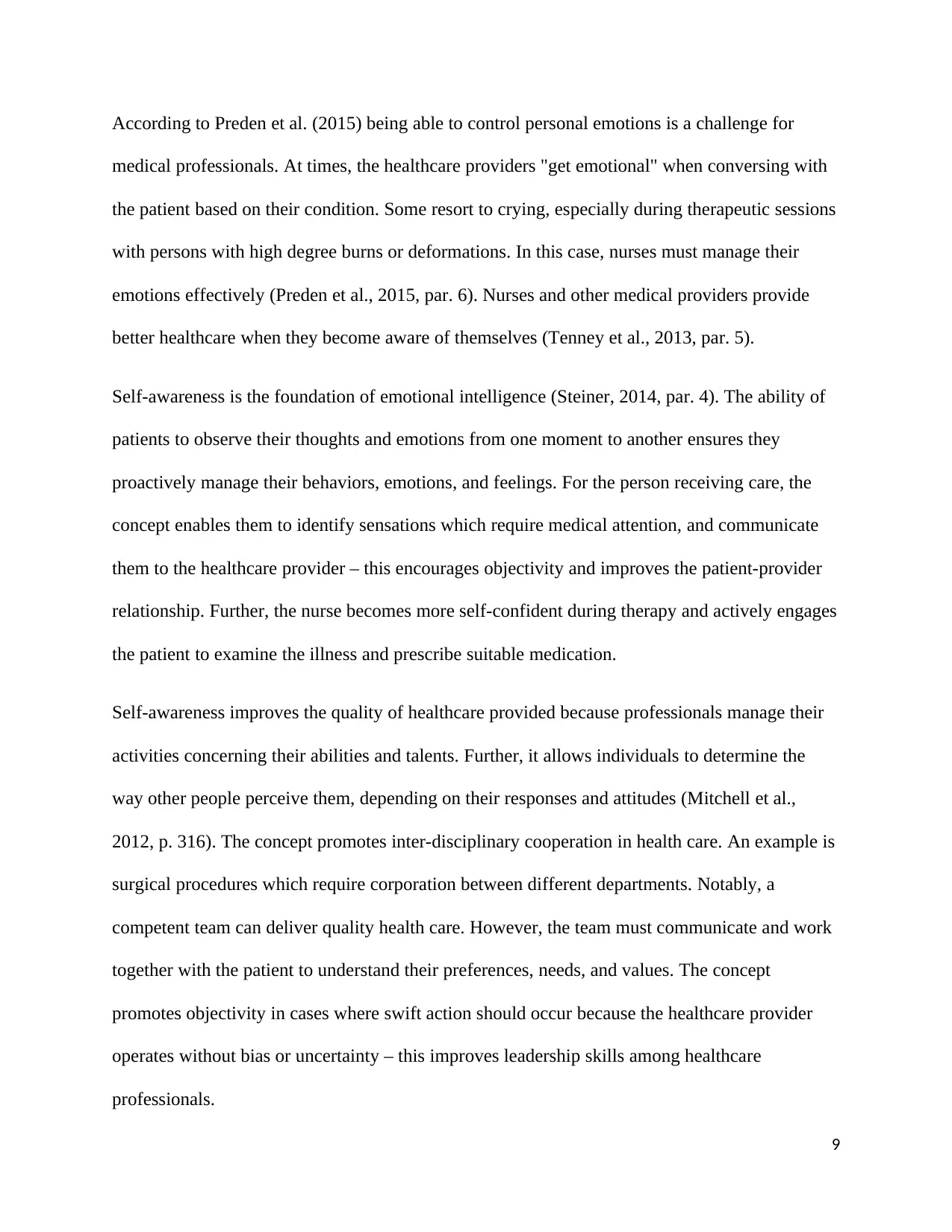
According to Preden et al. (2015) being able to control personal emotions is a challenge for
medical professionals. At times, the healthcare providers "get emotional" when conversing with
the patient based on their condition. Some resort to crying, especially during therapeutic sessions
with persons with high degree burns or deformations. In this case, nurses must manage their
emotions effectively (Preden et al., 2015, par. 6). Nurses and other medical providers provide
better healthcare when they become aware of themselves (Tenney et al., 2013, par. 5).
Self-awareness is the foundation of emotional intelligence (Steiner, 2014, par. 4). The ability of
patients to observe their thoughts and emotions from one moment to another ensures they
proactively manage their behaviors, emotions, and feelings. For the person receiving care, the
concept enables them to identify sensations which require medical attention, and communicate
them to the healthcare provider – this encourages objectivity and improves the patient-provider
relationship. Further, the nurse becomes more self-confident during therapy and actively engages
the patient to examine the illness and prescribe suitable medication.
Self-awareness improves the quality of healthcare provided because professionals manage their
activities concerning their abilities and talents. Further, it allows individuals to determine the
way other people perceive them, depending on their responses and attitudes (Mitchell et al.,
2012, p. 316). The concept promotes inter-disciplinary cooperation in health care. An example is
surgical procedures which require corporation between different departments. Notably, a
competent team can deliver quality health care. However, the team must communicate and work
together with the patient to understand their preferences, needs, and values. The concept
promotes objectivity in cases where swift action should occur because the healthcare provider
operates without bias or uncertainty – this improves leadership skills among healthcare
professionals.
9
medical professionals. At times, the healthcare providers "get emotional" when conversing with
the patient based on their condition. Some resort to crying, especially during therapeutic sessions
with persons with high degree burns or deformations. In this case, nurses must manage their
emotions effectively (Preden et al., 2015, par. 6). Nurses and other medical providers provide
better healthcare when they become aware of themselves (Tenney et al., 2013, par. 5).
Self-awareness is the foundation of emotional intelligence (Steiner, 2014, par. 4). The ability of
patients to observe their thoughts and emotions from one moment to another ensures they
proactively manage their behaviors, emotions, and feelings. For the person receiving care, the
concept enables them to identify sensations which require medical attention, and communicate
them to the healthcare provider – this encourages objectivity and improves the patient-provider
relationship. Further, the nurse becomes more self-confident during therapy and actively engages
the patient to examine the illness and prescribe suitable medication.
Self-awareness improves the quality of healthcare provided because professionals manage their
activities concerning their abilities and talents. Further, it allows individuals to determine the
way other people perceive them, depending on their responses and attitudes (Mitchell et al.,
2012, p. 316). The concept promotes inter-disciplinary cooperation in health care. An example is
surgical procedures which require corporation between different departments. Notably, a
competent team can deliver quality health care. However, the team must communicate and work
together with the patient to understand their preferences, needs, and values. The concept
promotes objectivity in cases where swift action should occur because the healthcare provider
operates without bias or uncertainty – this improves leadership skills among healthcare
professionals.
9
⊘ This is a preview!⊘
Do you want full access?
Subscribe today to unlock all pages.

Trusted by 1+ million students worldwide
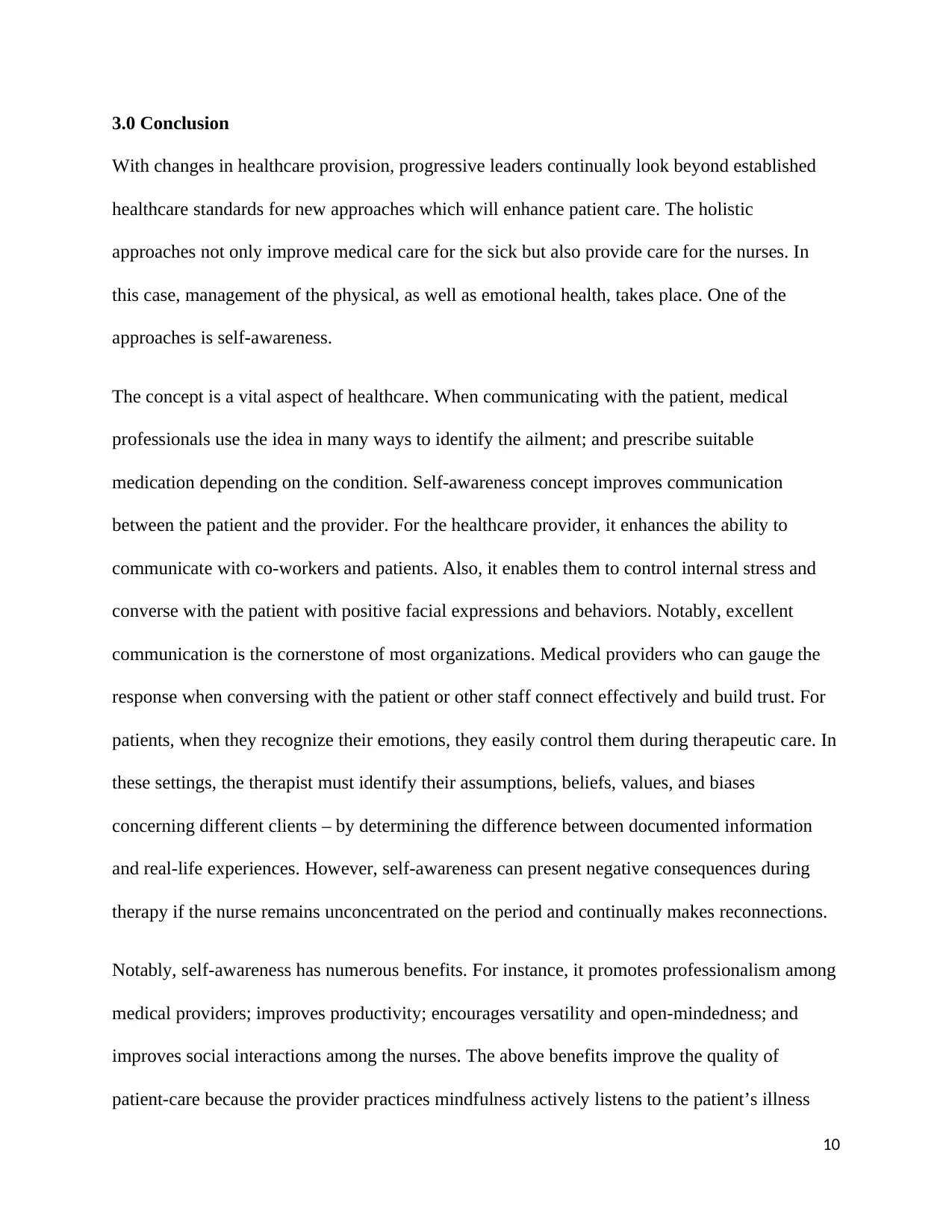
3.0 Conclusion
With changes in healthcare provision, progressive leaders continually look beyond established
healthcare standards for new approaches which will enhance patient care. The holistic
approaches not only improve medical care for the sick but also provide care for the nurses. In
this case, management of the physical, as well as emotional health, takes place. One of the
approaches is self-awareness.
The concept is a vital aspect of healthcare. When communicating with the patient, medical
professionals use the idea in many ways to identify the ailment; and prescribe suitable
medication depending on the condition. Self-awareness concept improves communication
between the patient and the provider. For the healthcare provider, it enhances the ability to
communicate with co-workers and patients. Also, it enables them to control internal stress and
converse with the patient with positive facial expressions and behaviors. Notably, excellent
communication is the cornerstone of most organizations. Medical providers who can gauge the
response when conversing with the patient or other staff connect effectively and build trust. For
patients, when they recognize their emotions, they easily control them during therapeutic care. In
these settings, the therapist must identify their assumptions, beliefs, values, and biases
concerning different clients – by determining the difference between documented information
and real-life experiences. However, self-awareness can present negative consequences during
therapy if the nurse remains unconcentrated on the period and continually makes reconnections.
Notably, self-awareness has numerous benefits. For instance, it promotes professionalism among
medical providers; improves productivity; encourages versatility and open-mindedness; and
improves social interactions among the nurses. The above benefits improve the quality of
patient-care because the provider practices mindfulness actively listens to the patient’s illness
10
With changes in healthcare provision, progressive leaders continually look beyond established
healthcare standards for new approaches which will enhance patient care. The holistic
approaches not only improve medical care for the sick but also provide care for the nurses. In
this case, management of the physical, as well as emotional health, takes place. One of the
approaches is self-awareness.
The concept is a vital aspect of healthcare. When communicating with the patient, medical
professionals use the idea in many ways to identify the ailment; and prescribe suitable
medication depending on the condition. Self-awareness concept improves communication
between the patient and the provider. For the healthcare provider, it enhances the ability to
communicate with co-workers and patients. Also, it enables them to control internal stress and
converse with the patient with positive facial expressions and behaviors. Notably, excellent
communication is the cornerstone of most organizations. Medical providers who can gauge the
response when conversing with the patient or other staff connect effectively and build trust. For
patients, when they recognize their emotions, they easily control them during therapeutic care. In
these settings, the therapist must identify their assumptions, beliefs, values, and biases
concerning different clients – by determining the difference between documented information
and real-life experiences. However, self-awareness can present negative consequences during
therapy if the nurse remains unconcentrated on the period and continually makes reconnections.
Notably, self-awareness has numerous benefits. For instance, it promotes professionalism among
medical providers; improves productivity; encourages versatility and open-mindedness; and
improves social interactions among the nurses. The above benefits improve the quality of
patient-care because the provider practices mindfulness actively listens to the patient’s illness
10
Paraphrase This Document
Need a fresh take? Get an instant paraphrase of this document with our AI Paraphraser
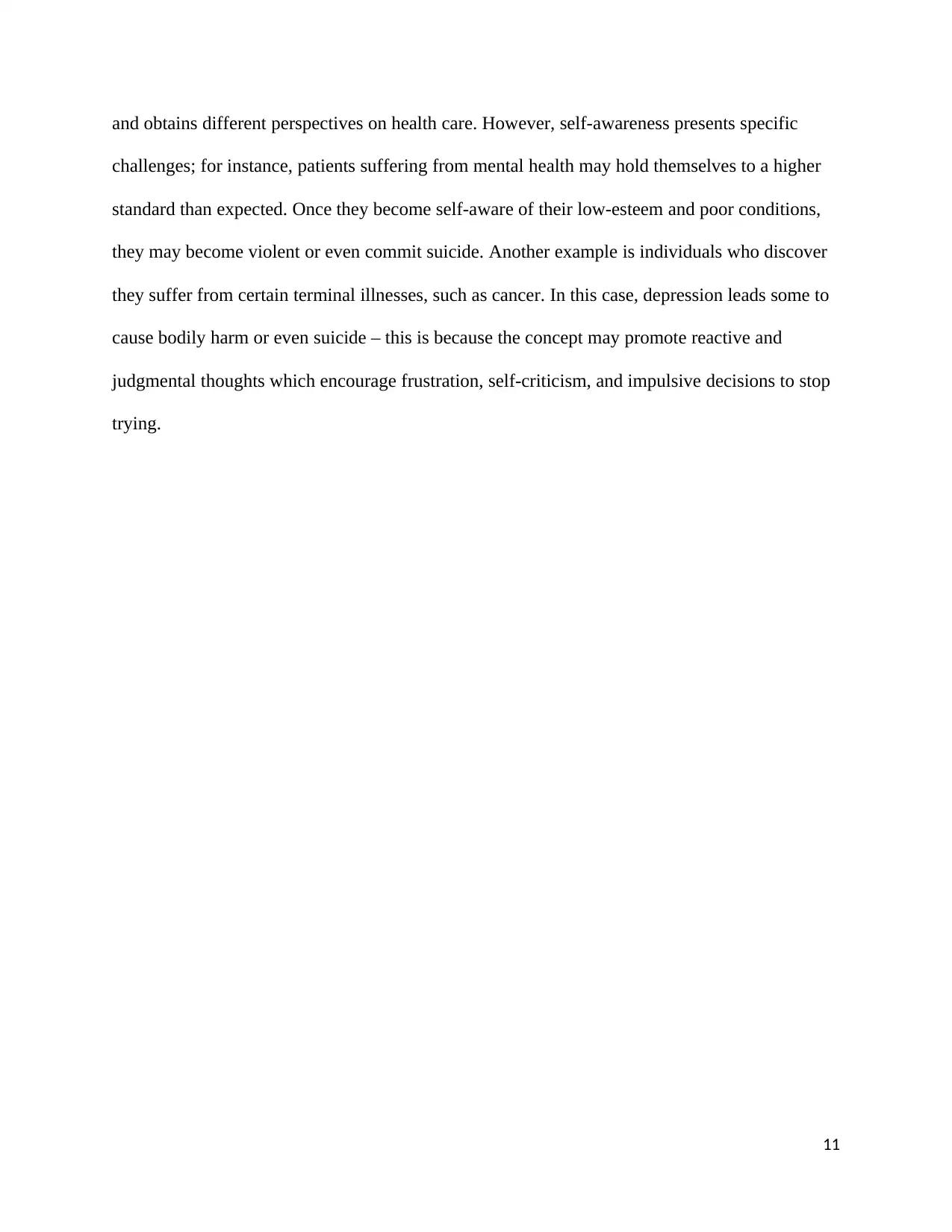
and obtains different perspectives on health care. However, self-awareness presents specific
challenges; for instance, patients suffering from mental health may hold themselves to a higher
standard than expected. Once they become self-aware of their low-esteem and poor conditions,
they may become violent or even commit suicide. Another example is individuals who discover
they suffer from certain terminal illnesses, such as cancer. In this case, depression leads some to
cause bodily harm or even suicide – this is because the concept may promote reactive and
judgmental thoughts which encourage frustration, self-criticism, and impulsive decisions to stop
trying.
11
challenges; for instance, patients suffering from mental health may hold themselves to a higher
standard than expected. Once they become self-aware of their low-esteem and poor conditions,
they may become violent or even commit suicide. Another example is individuals who discover
they suffer from certain terminal illnesses, such as cancer. In this case, depression leads some to
cause bodily harm or even suicide – this is because the concept may promote reactive and
judgmental thoughts which encourage frustration, self-criticism, and impulsive decisions to stop
trying.
11
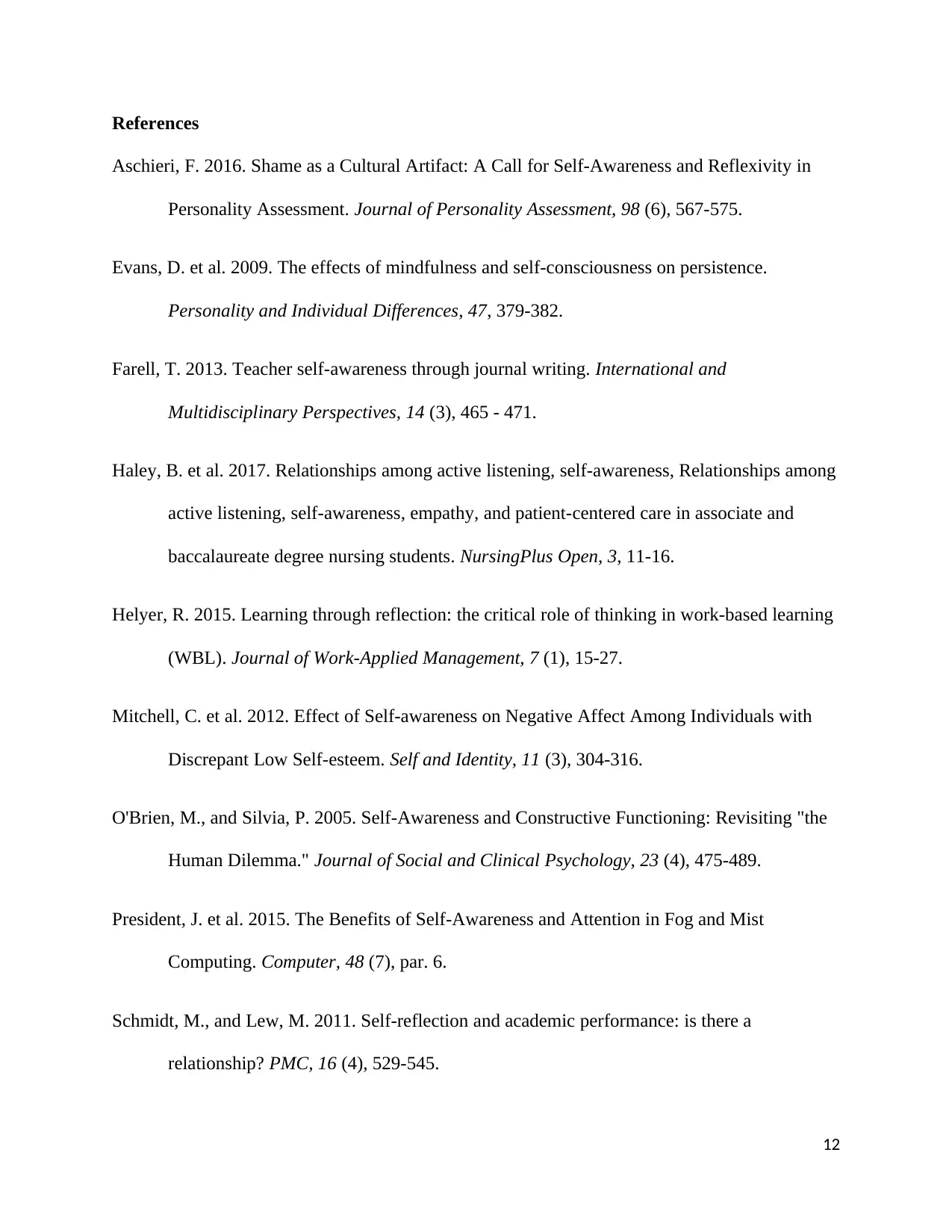
References
Aschieri, F. 2016. Shame as a Cultural Artifact: A Call for Self-Awareness and Reflexivity in
Personality Assessment. Journal of Personality Assessment, 98 (6), 567-575.
Evans, D. et al. 2009. The effects of mindfulness and self-consciousness on persistence.
Personality and Individual Differences, 47, 379-382.
Farell, T. 2013. Teacher self-awareness through journal writing. International and
Multidisciplinary Perspectives, 14 (3), 465 - 471.
Haley, B. et al. 2017. Relationships among active listening, self-awareness, Relationships among
active listening, self-awareness, empathy, and patient-centered care in associate and
baccalaureate degree nursing students. NursingPlus Open, 3, 11-16.
Helyer, R. 2015. Learning through reflection: the critical role of thinking in work-based learning
(WBL). Journal of Work-Applied Management, 7 (1), 15-27.
Mitchell, C. et al. 2012. Effect of Self-awareness on Negative Affect Among Individuals with
Discrepant Low Self-esteem. Self and Identity, 11 (3), 304-316.
O'Brien, M., and Silvia, P. 2005. Self-Awareness and Constructive Functioning: Revisiting "the
Human Dilemma." Journal of Social and Clinical Psychology, 23 (4), 475-489.
President, J. et al. 2015. The Benefits of Self-Awareness and Attention in Fog and Mist
Computing. Computer, 48 (7), par. 6.
Schmidt, M., and Lew, M. 2011. Self-reflection and academic performance: is there a
relationship? PMC, 16 (4), 529-545.
12
Aschieri, F. 2016. Shame as a Cultural Artifact: A Call for Self-Awareness and Reflexivity in
Personality Assessment. Journal of Personality Assessment, 98 (6), 567-575.
Evans, D. et al. 2009. The effects of mindfulness and self-consciousness on persistence.
Personality and Individual Differences, 47, 379-382.
Farell, T. 2013. Teacher self-awareness through journal writing. International and
Multidisciplinary Perspectives, 14 (3), 465 - 471.
Haley, B. et al. 2017. Relationships among active listening, self-awareness, Relationships among
active listening, self-awareness, empathy, and patient-centered care in associate and
baccalaureate degree nursing students. NursingPlus Open, 3, 11-16.
Helyer, R. 2015. Learning through reflection: the critical role of thinking in work-based learning
(WBL). Journal of Work-Applied Management, 7 (1), 15-27.
Mitchell, C. et al. 2012. Effect of Self-awareness on Negative Affect Among Individuals with
Discrepant Low Self-esteem. Self and Identity, 11 (3), 304-316.
O'Brien, M., and Silvia, P. 2005. Self-Awareness and Constructive Functioning: Revisiting "the
Human Dilemma." Journal of Social and Clinical Psychology, 23 (4), 475-489.
President, J. et al. 2015. The Benefits of Self-Awareness and Attention in Fog and Mist
Computing. Computer, 48 (7), par. 6.
Schmidt, M., and Lew, M. 2011. Self-reflection and academic performance: is there a
relationship? PMC, 16 (4), 529-545.
12
⊘ This is a preview!⊘
Do you want full access?
Subscribe today to unlock all pages.

Trusted by 1+ million students worldwide
1 out of 13
Related Documents
Your All-in-One AI-Powered Toolkit for Academic Success.
+13062052269
info@desklib.com
Available 24*7 on WhatsApp / Email
![[object Object]](/_next/static/media/star-bottom.7253800d.svg)
Unlock your academic potential
Copyright © 2020–2025 A2Z Services. All Rights Reserved. Developed and managed by ZUCOL.





